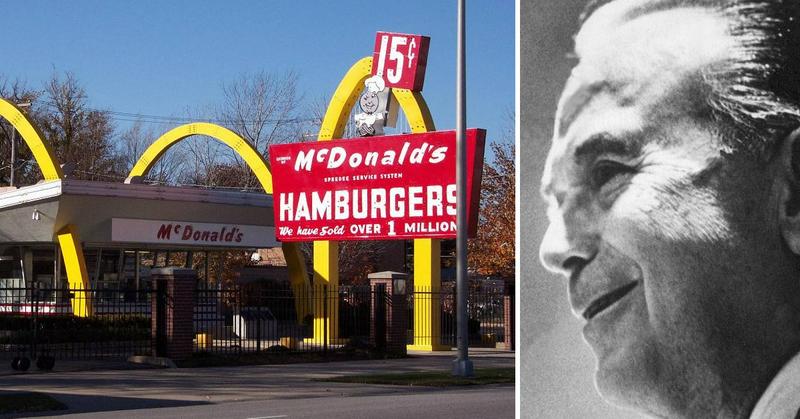Ray Kroc: McDonald's Founder's Life, Legacy, And Stories
By | April 14, 2020

The sign says McDonald's, but it's Ray Kroc whose name and face are on the plaque inside. Fast food as we know it was shaped by the late Kroc, who opened his first McDonald's franchise in 1955 and built a global empire. A hero of American business, Ray Kroc is the man to thank (or blame) for all the Big Macs, McDonald's fries, Filet-O-Fishes, or Happy Meals you've eaten in your life. The facts of Ray Kroc's achievements and the story of his life are inspiring, to say the least

Ray Kroc, who was born on October 5, 1902 in Oak Park, Illinois, worked a variety of jobs before becoming the multi-millionaire tycoon. He sold paper cups, worked as a real estate agents, and even played the piano in bands. Kroc was selling milkshake mixers for Prince Castle, when he first encountered Richard and Maurice McDonald. They had purchased eight of his mixers for their San Bernardino, California location, and Kroc was impressed with their operation. Their restaurants were clean and mechanized, and the employees were well-groomed and professional. Kroc opened his first location in Des Plaines, Illinois on April 15, 1955. The location stood until 1985, when it was demolished. Five years, later, they rehabilitated the site and built a museum and gift shop next to it.
The Money Is In The Real Estate

McDonalds makes more money in real estate than it does selling fast food, even though it is the largest hamburger fast food chain and serves about 66 million people every single day. Their real estate vision did not come from Ray Kroc, but rather an employee, Harry Sonnenborn. When Kroc was struggling to open up multiple locations quickly, he encountered financial hurdles. Sonneborn’s solution was to lease the land rather than buy it outright, and then sublease it to the franchisee, who managed the restaurant. Because of this business model, Kroc bought out the McDonald brothers for 2.7 million dollars in 1961 and in 1963, Kroc opened his 500th location.
Kroc Drove The Original Out Of Business

When Kroc bought the chain, the McDonald brothers refused to sell him the original San Berardino location, deciding to give the original location to the founding employees. The McDonald brothers had not retaine rights to the name of the chain, so they renamed the original restaurant “The Big M.” Kroc opened a McDonalds near “The Big M,” and that original location closed six years later.
Attempts At Other Innovations

In addition to keeping the name of the fast food chain, he kept the speed of service employed by the McDonald brothers and refunded money to customers who waited more than five minutes for their food. Kroc also standardized food production. Kroc was willing to try new additions to the menu, including, for a limited time, pizza. This menu item didn’t last long as production ran into far too many hurdles that this venture was a failure, only being tested in limited markets. At one point, they also tried out McSpaghetti, fajitas, and a baked French toast called McStuffin. There was one food however, that he vowed McDonalds would never serve: the hot dog. According to Kroc, there was no knowing what was inside a hot dog and hot dogs were below the standard of quality Kroc accepted. The company did try out the McHotdog though, notably in the Rogers Centre, the home of the Toronto Blue Jays.
Creating An Educational Institution

Kroc was a pioneer in other ways as well; he opened the first corporate training center, known as Hamburger University, in 1961 in the basement of the Oak Grove, Illinois location. It was run by Fred Turner, the first grill man for McDonalds, who later became CEO for 20 years. Hamburger University employs 16 full-time professors and can teach in 28 languages. Students do not learn how to flip burgers at the university, instead focusing on real-life management skills. One of the important things that they learn is the “three-legged stool” business model, another idea that Kroc gave to the business world. In 1983, the University had expanded to $40 million dollar facility and there were branches around the world. It is not easy to get into Hamburger University, which is actually a highly competitive program. Graduates of the University receive a “Bachelor of Hamburgerology” Diploma.
He Had A Famous Butler

With his success, Kroc was able to hire a butler, something not unusual perhaps, but what was unusual was the fact that his butler had been famous prior to working for Kroc. The butler, Patrick Dennis, had been a well-known author who had written the best-selling novel, Auntie Mame. Patrick Dennis, however, was a pseudonym and Kroc knew him by his given surname, Tanner.
A Charitable Man

Kroc also put his money to good uses, establishing the Ray Kroc Foundation. The Foundation donated millions to charities, with a focus on medical conditions. The Foundation notably established the Ronald McDonald Houses, to provide housing near medical facilities for families whose children have been hospitalized. Kroc also donated a large sum of money to Richard Nixon's 1972 reelection campaign.
Life After Retirement

Kroc retired in 1974, and purchased the San Diego Padres. The year after he bought the team, attendance improved substantially. When he died in 1984, the team wore a patch with his initials, RAK; that same year, the Padres played in the World Series and in 1999, Kroc was inducted into the Padres Hall of Fame.
Kroc suffered a stroke in 1980 and then entered an alcohol rehabilitation facility. He died of heart failure in 1984. After Kroc’s death, Joan, his third wife, increased philanthropy, including a 1.5 million dollar donation to the Salvation Army to build Kroc Centers, community centers to serve underserved neighborhoods.
